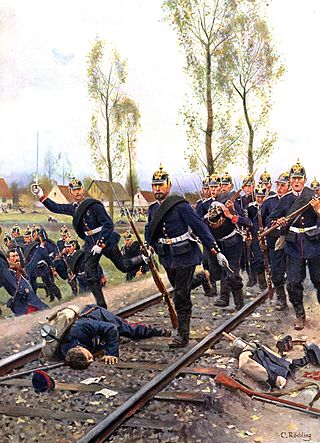
The Paris Commune was a French revolutionary government that seized power in Paris from 18 March to 28 May 1871.

Gonesse is a commune in the Val-d'Oise department, in the north-eastern suburbs of Paris, France. It is located 16.5 km (10.3 mi) from the centre of Paris.

The following is a timeline of the French Revolution.

The Paris Commune during the French Revolution was the government of Paris from 1789 until 1795. Established in the Hôtel de Ville just after the storming of the Bastille, it consisted of 144 delegates elected by the 60 divisions of the city. Before its formal establishment, there had been much popular discontent on the streets of Paris over who represented the true Commune, and who had the right to rule the Parisian people. The first mayor was Jean Sylvain Bailly, a relatively moderate Feuillant who supported constitutional monarchy. He was succeeded in November 1791 by Pétion de Villeneuve after Bailly's unpopular use of the National Guard to disperse a riotous assembly in the Champ de Mars.

Louis Charles Delescluze was a French revolutionary leader, journalist, and military commander of the Paris Commune.

The siege of Paris took place from 19 September 1870 to 28 January 1871 and ended in the capture of the city by forces of the various states of the North German Confederation, led by the Kingdom of Prussia. The siege was the culmination of the Franco-Prussian War, which saw the Second French Empire attempt to reassert its dominance over continental Europe by declaring war on the North German Confederation. The Prussian-dominated North German Confederation had recently emerged victorious in the Austro-Prussian War of 1866, which led to the questioning of France's status as the dominant power of continental Europe. With a declaration of war by the French parliament on 16 July 1870, Imperial France soon faced a series of defeats at German hands over the following months, leading to the Battle of Sedan, which, on 2 September 1870, saw a decisive defeat of French forces and the capture of the French emperor, Napoleon III.

The Hôtel de Ville is the city hall of Paris, France, standing on the Place de l'Hôtel-de-Ville – Esplanade de la Libération in the 4th arrondissement. The south wing was originally constructed by François I beginning in 1535 until 1551. The north wing was built by Henry IV and Louis XIII between 1605 and 1628. It was burned by the Paris Commune, along with all the city archives that it contained, during the Semaine Sanglante, the Commune's final days, in May 1871. The outside was rebuilt following the original design, but larger, between 1874 and 1882, while the inside was considerably modified. It has been the headquarters of the municipality of Paris since 1357. It serves multiple functions, housing the local government council, since 1977 the Mayors of Paris and their cabinets, and also serves as a venue for large receptions.

The Musée Carnavalet in Paris is dedicated to the history of the city. The museum occupies two neighboring mansions: the Hôtel Carnavalet and the former Hôtel Le Peletier de Saint Fargeau. On the advice of Baron Haussmann, the civil servant who transformed Paris in the latter half of the 19th century, the Hôtel Carnavalet was purchased by the Municipal Council of Paris in 1866; it was opened to the public in 1880. By the latter part of the 20th century, the museum was full to capacity. The Hôtel Le Peletier de Saint Fargeau was annexed to the Carnavalet and opened to the public in 1989.

The First battle of Le Bourget was part of the siege of Paris during the Franco-Prussian War, fought between 27 and 30 October 1870.

The Government of National Defense was the first government of the Third Republic of France from 4 September 1870 to 13 February 1871 during the Franco-Prussian War. It was formed after the proclamation of the Republic in Paris on 4 September, which in turn followed the surrender and capture of Emperor Napoleon III by the Prussians at the Battle of Sedan. The government, headed by General Louis Jules Trochu, was under Prussian siege in Paris. Breakouts were attempted twice, but met with disaster and rising dissatisfaction of the public. In late January the government, having further enraged the population of Paris by crushing a revolutionary uprising, surrendered to the Prussians. Two weeks later, it was replaced by the new government of Adolphe Thiers, which soon passed a variety of financial laws in an attempt to pay reparations and thus oblige the Prussians to leave France, leading to the outbreak of revolutions in French cities, and the ultimate creation of the Paris Commune.

The Thiers wall was the last of the defensive walls of Paris. It was an enclosure constructed between 1841 and 1846 and was proposed by the French prime minister Adolphe Thiers but was actually implemented by his successor. The 33 kilometres (21 mi) long wall and ditch made a complete circuit around the city as it stood at the time of the July Monarchy. It was bombarded by the Prussian Army during the Franco-Prussian War, captured by government troops during the Paris Commune and refortified at the start of the First World War. However, by then it had become obsolete as a fortification and was a barrier to the expansion of the city. The area immediately outside of it, known as "the zone", had become a shanty town. The wall was demolished in the interwar period; its path today can be traced by the Boulevards of the Marshals which originally ran just behind the fortifications and by the Boulevard Périphérique which was later built just outside. A few remnants of the wall can still be seen.

Paul-Antoine Brunel was a French general. He was a French lieutenant who became a leader of the Paris Commune during the Siege of Paris in 1870. He broke into Paris through the Prussian siege.

The Armistice of Versailles that came into effect on 28 January 1871 brought to an end the active phase of the Franco-Prussian War. The signatories were Jules Favre, foreign minister in the provisional Government of National Defence, for the French and Otto von Bismarck, chancellor of the newly established German Empire, for Prussia and her allies. The suspension of hostilities initially lasted until 19 February, when it was extended through 26 February, when a preliminary peace treaty was signed, also at Versailles. The definitive Treaty of Frankfurt was signed on 10 May. Although technically an armistice, the military position of France at the time and the terms were such that it was de facto a conditional surrender by the vanquished to the victors.
This chronology of the Paris Commune lists major events that occurred during and surrounding the Paris Commune, a revolutionary government that controlled Paris between March and May 1871.

The semaine sanglante was a weeklong battle in Paris from 21 to 28 May 1871, during which the French Army recaptured the city from the Paris Commune. This was the final battle of the Paris Commune.
The Commune Council, simply known as the Commune, was the government during the 72-day Paris Commune in 1871. Following elections on 26 March, the municipal council adopted the formal name Paris Commune in its first session, implying a more revolutionary intent. The council declared itself and its name on 28 March at the Hôtel de Ville as a celebratory event. Their first proclamation followed the next day, reminding citizens of their autonomy and warning of civil war. The Commune was supported by the vast majority of Parisians. The Central Committee of the National Guard recognized and relinquished power to the Commune, but continued to organize as the "guardian of the revolution". The two groups exercised a de facto dual sovereignty.

On 1 March 1871 the Imperial German Army paraded through Paris to mark their victory in the Franco-Prussian War. The city had been under siege by Prussian forces since September 1870, with Prussia being unified into the German Empire on 18 January 1871. The Armistice of Versailles of 28 January ended hostilities, but the city remained in French hands. Preliminary peace terms were agreed in the 26 February Treaty of Versailles, which allowed 30,000 German troops to occupy Paris from 1 March until the treaty was ratified.

On January 22, 1871, a contingent of France's National Guard marched on Paris's City Hall. The group opposed the armistice that was being drafted, believing that the French government had sabotaged their military. Demonstrators released Gustave Flourens and marched on the City Hall, including 150 guardsmen. But unlike the larger City Hall uprising three months earlier, Breton Mobile Guards defended the building. Five died, and 18 were wounded. Though the event had been smaller than the October uprising, the January insurrection irreconcilably split Paris's factions and presaged the coming civil war.

The Federated Legion of Women was an armed unit composed of women active during the Paris Commune in May 1871. It was founded in the 12th arrondissement, with the intended mission of hunting down deserters. The legion had uniforms, parades, and a standard-bearer, and was led by two officers, Colonel Adélaïde Valentin and Captain Louise Neckbecker. There were an estimated 20-100 members, most from working-class backgrounds. They held and attended meetings in Parisian political clubs, where they incited citizens to take up arms. After the defeat of the Commune, arrested members were given heavy sentences, including forced labour and deportation.
The Binant Series (Scenes of civilian and military life) (French - Suite Binant - Scènes de la vie civile et militaire) was a series of 36 large-format paintings commissioned by (and named after) Parisian art-material dealer Alfred Binant (1822-1904) in the wake of the Siege of Paris. 13 artists were involved, producing a precious record of the recent Franco-Prussian War and Paris Commune, first exhibited in 1872. Only thirteen of the full paintings survive, all of which are now in the Musée Carnavalet, though 36 modellos for the series were rediscovered in the stores of the Musée Gassendi in Digne-les-Bains in June 2017.
















